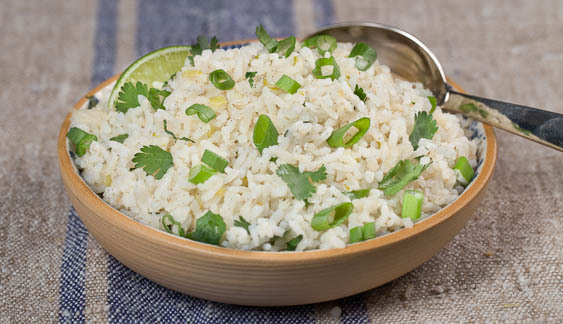Caribbean Coconut-Scallion Rice

introduction
This coconut rice fuses ancient Polynesian rice culture with alluring New World spices and speaks provenance in the language of aroma and flavor. When you taste it, you taste Caribbean Islands, not a complicated trail of coconut or spices. Let’s take this praise one step further: anyone who tastes coconut rice knows that this is great food.
Think the tropics and aromatic roots, herbs you might grow, spices you might harvest, water from a fresh cracked coconut, and new crop rice. That is the magic we chase in this dish. The objective—on the Islands, in your kitchen, wherever—is for flavors to perform beyond their ingredients. You won’t be able to describe the evolving layered nuances of coconut rice in a single word, but a descriptive phrase in an ancient language might suffice.
Serve the rice with Whole Roasted Snapper or any main dish of a tropical persuasion. It’s also excellent with a mound of fluffy scrambled eggs.
Cooking Remarks
In the Caribbean, this rice would be cooked in the water released by cracking open a fresh coconut. We fabricated a concoction of unsweetened coconut flakes and hot water steeped and blended into a frothy liquid. It is a reliable alternative to the many different commercial products bearing the names coconut water or coconut milk, some of which have no flavor and others whose processing has robbed them of any sort of freshness.
Coconut oil, which resembles butter more than oil, of course, makes a welcome appearance in this dish, too. If you buy coconut oil, be sure to seek out a jar labeled virgin or unrefined. And to build even greater the coconut complexity, we also suggest adding a couple teaspoons of coconut butter. By far the most exceptional product of this description is sold by CAP Beauty in NYC. Their stone-ground butter made from the whole coconut is nothing short of ethereal. We used it to make the rice on one occasion and were blown away by its contribution.
If the vanilla bean strikes you as a misplaced ingredient, it is not! These barely-there little specks add enticing aroma and sultry flavor notes like no other spice, savory or sweet. The vanilla calls no attention to itself. Rather, it harmonizes beautifully with the coconut and the cilantro, especially, and makes the rice hauntingly good.
It’s important to measure the coconut milk for cooking the rice by weight rather than volume. Anson Mills Carolina Gold Rice has a small window for hydration—too much or too little liquid may leave the grains less than perfectly cooked.
equipment mise en place
For this recipe, you will need a digital kitchen scale, two fine-mesh strainers, a blender, a 1-quart liquid measuring cup or medium bowl, a silicone spatula, a heavy-bottomed medium saucepan, and a clean kitchen towel.
-
-
11ounces (1½ cups) Anson Mills Carolina Gold Rice
-
2ounces (1 cup) unsweetened shredded coconut
-
3cups spring or filtered water, boiling
-
1(1-inch) piece vanilla bean
-
10slender scallions
-
1tablespoon virgin coconut oil or unsalted butter
-
0.6ounce fresh ginger, peeled and sliced ⅛ inch thick
-
¼cup plus 2 tablespoons minced fresh cilantro leaves
-
⅛teaspoon ground mace
-
Pinch of cayenne pepper
-
2teaspoons coconut butter (optional; see Cooking Remarks)
-
Scant 1 teaspoon fine sea salt
-
Lime wedges, for serving
-
-
Pour the rice into a fine-mesh strainer and rinse well under running cool water. Vigorously shake off the excess water by bouncing the rice up and down in the strainer. Set the strainer over a small bowl and set aside to let the rice dry while you make the coconut milk and prep the scallions.
-
Add the coconut to a blender and pour in the boiling water. Let the coconut soften for 15 to 20 minutes, then blend on high until the mixture is creamy, about 1 minute. Set another fine-mesh strainer over a 1-quart liquid measuring cup or a medium bowl, then pour the coconut mixture into the strainer. Press on the coconut in the strainer with a silicone spatula to extract as much liquid as possible. You should have about 2½ cups strained coconut milk. Discard the coconut in the strainer. Weigh out 17.5 ounces of the coconut milk for cooking the rice; reserve the remainder for another use. Using a paring knife, slice the vanilla bean in half lengthwise, scrape the seeds into the coconut milk, and drop in the pods.
-
Very thinly slice the white and light green parts of the scallions; leave the dark green parts whole and set them aside for later. In a heavy-bottomed medium saucepan, warm the coconut oil over medium heat. Add the scallion whites, the ginger, the ¼ cup cilantro, the mace, and cayenne and cook, stirring occasionally, until the scallions have practically melted but have not browned, 3 to 4 minutes. Stir in the coconut butter, if using. Pour in the coconut milk and add the salt, then increase the heat to medium-high and bring the mixture to a boil. Add the rice and stir, then cover the pan and turn down the heat to low. Cook the rice for 18 minutes without peeking into the pan.
-
Turn off the heat. Quickly uncover the pan, lay a clean kitchen towel across the top, then replace the cover. Let stand for 10 minutes.
-
Thinly slice the reserved dark green parts of the scallions. Uncover the pan and fluff the rice with a fork. Remove and discard the ginger slices and pieces of vanilla pod. Add the scallion greens and the remaining 2 tablespoons cilantro and fluff the herbs into the rice. Turn the rice into a warmed serving bowl and garnish with lime wedges.